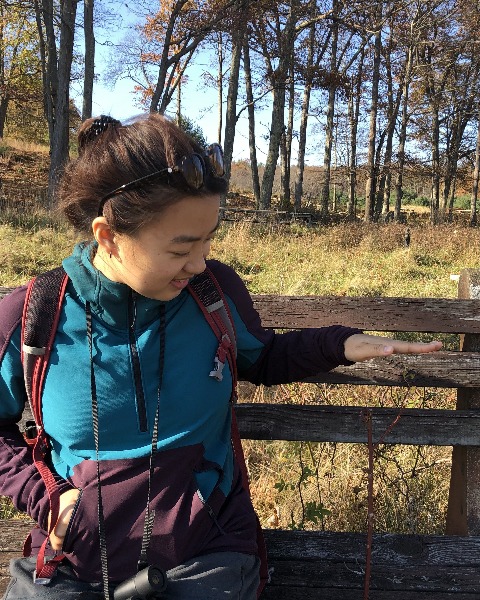Back
Contributed Talk
Session: Modeling: Communities, Disturbance, Succession 1
COS 15-2 - Decipher the enigma of bamboo biology through the lens of arresting succession
Monday, August 15, 2022
1:45 PM – 2:00 PM EDT
Location: 516B

Aiyu Zheng
graduate student
Princeton University
Princeton, New Jersey, United States- SP
Stephen Pacala
Princeton University, United States
Presenting Author(s)
Coauthor(s)
Background/Question/Methods
Bamboo is a group of perennial grasses ecologically important to the structure and function of forests. While bamboo is disadvantaged in competition with other woody species due to its shade intolerance and lack of secondary xylem, it manages to coexist with trees in forest canopies and sometimes outcompete trees. Interestingly, unlike other shade-intolerant and structurally inferior species, bamboo does not take the opportunist’s strategy of frequently dispersing seeds into gaps. Paradoxically, bamboo postpones seed production for decades and flowers semeparously and synchronously.
We hypothesize that bamboo’s seemingly contradictory attributes can be explained by its strategy to arrest succession. To test this hypothesis, we constructed mathematical models to examine the mechanistic underpinnings of bamboo’s canopy dominance in forest ecosystems. In these models, we assume that bamboo and trees compete on open gaps via seed and vegetative dispersal under different disturbance scenarios. We conducted invasion analysis to solve for life history traits and disturbance regimes that allow bamboo to successfully invade trees when rare and to arrest succession when abundant. For completeness, we analyzed our model on two different pseudo-spatial topologies (mean-field and patch-based), and also built a cellular automaton to implement competition in explicit space and examined the consistency of results.
Results/Conclusions
Results of our modeling analysis showed that bamboo utilizes a density strategy, relying on dense seeds or culms sprouted from rhizomes to fill the canopy quickly before trees overtop bamboo. Furthermore, we found that bamboos in different habitats invest in different life-history traits such as seed dispersal, culm dispersal, and flowering interval in order to arrest succession. Our model solves the conditions for a trade-off between bamboo’s investment in clonal vs. sexual reproduction: when survival rate of culms in resource-poor understories is low, bamboo tends to invest more in seed dispersal to capture gaps.
We also revealed that the timing and frequency of disturbances such as fire and drought significantly impact the competition results between trees and bamboo. Our simulation results suggest that bamboo with high culm dispersal rates and longer flowering intervals might be disadvantaged if disturbances occur frequently during bamboo's vegetative period but favored if disturbances occur frequently during bamboo's flowering phase.
Altogether, we provided the first theoretical explanation of diverse bamboo life history strategies observed under different disturbance regimes and resource conditions. Our findings also identified critical empirical questions and opened up new avenues for future research to advance our understanding of tree-bamboo coexistence and bamboo invasion.
Bamboo is a group of perennial grasses ecologically important to the structure and function of forests. While bamboo is disadvantaged in competition with other woody species due to its shade intolerance and lack of secondary xylem, it manages to coexist with trees in forest canopies and sometimes outcompete trees. Interestingly, unlike other shade-intolerant and structurally inferior species, bamboo does not take the opportunist’s strategy of frequently dispersing seeds into gaps. Paradoxically, bamboo postpones seed production for decades and flowers semeparously and synchronously.
We hypothesize that bamboo’s seemingly contradictory attributes can be explained by its strategy to arrest succession. To test this hypothesis, we constructed mathematical models to examine the mechanistic underpinnings of bamboo’s canopy dominance in forest ecosystems. In these models, we assume that bamboo and trees compete on open gaps via seed and vegetative dispersal under different disturbance scenarios. We conducted invasion analysis to solve for life history traits and disturbance regimes that allow bamboo to successfully invade trees when rare and to arrest succession when abundant. For completeness, we analyzed our model on two different pseudo-spatial topologies (mean-field and patch-based), and also built a cellular automaton to implement competition in explicit space and examined the consistency of results.
Results/Conclusions
Results of our modeling analysis showed that bamboo utilizes a density strategy, relying on dense seeds or culms sprouted from rhizomes to fill the canopy quickly before trees overtop bamboo. Furthermore, we found that bamboos in different habitats invest in different life-history traits such as seed dispersal, culm dispersal, and flowering interval in order to arrest succession. Our model solves the conditions for a trade-off between bamboo’s investment in clonal vs. sexual reproduction: when survival rate of culms in resource-poor understories is low, bamboo tends to invest more in seed dispersal to capture gaps.
We also revealed that the timing and frequency of disturbances such as fire and drought significantly impact the competition results between trees and bamboo. Our simulation results suggest that bamboo with high culm dispersal rates and longer flowering intervals might be disadvantaged if disturbances occur frequently during bamboo's vegetative period but favored if disturbances occur frequently during bamboo's flowering phase.
Altogether, we provided the first theoretical explanation of diverse bamboo life history strategies observed under different disturbance regimes and resource conditions. Our findings also identified critical empirical questions and opened up new avenues for future research to advance our understanding of tree-bamboo coexistence and bamboo invasion.
